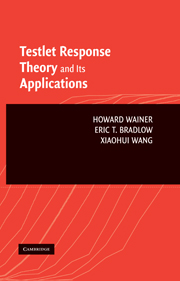Book contents
- Frontmatter
- Contents
- Preface
- PART I INTRODUCTION TO TESTLETS
- 1 Introduction
- 2 True score theory
- 3 Item response theory
- 4 What's a testlet and why do we need them?
- 5 The origins of testlet response theory – three alternatives
- 6 Fitting testlets with polytomous IRT models
- PART II BAYESIAN TESTLET RESPONSE THEORY
- PART III TWO APPLICATIONS AND A TUTORIAL
- Glossary of terms
- Epilogue
- Bibliography
- Author Index
- Subject Index
3 - Item response theory
Published online by Cambridge University Press: 08 January 2010
- Frontmatter
- Contents
- Preface
- PART I INTRODUCTION TO TESTLETS
- 1 Introduction
- 2 True score theory
- 3 Item response theory
- 4 What's a testlet and why do we need them?
- 5 The origins of testlet response theory – three alternatives
- 6 Fitting testlets with polytomous IRT models
- PART II BAYESIAN TESTLET RESPONSE THEORY
- PART III TWO APPLICATIONS AND A TUTORIAL
- Glossary of terms
- Epilogue
- Bibliography
- Author Index
- Subject Index
Summary
Item response theory (IRT) is a family of mathematical descriptions of what happens when an examinee meets an item. It stems from early notions that test items all ought to somehow measure the same thing (Loevinger, 1947). Originally, IRT formalized this by explicitly positing a single dimension of knowledge or underlying trait on which all examinees rely, to some extent, for their correct responses to all the test items (although recent research has generalized this to allow multidimensionality (Reckase, 1985, 1997; McDonald, 2000; Segall, 2001)). Examples of such traits are verbal proficiency, mathematical facility, jumping ability, or spatial memory. The position that each item occupies on this dimension is termed that item's difficulty (usually denoted as b); the position of each examinee on this dimension is that examinee's proficiency (usually denoted as θ). The IRT model gives the probability of answering a question correctly in terms of the difference between b and θ (both of which are unobservable). The simplest IRT model combines just these two elements within a logistic function. Because it characterizes each item with just a single parameter (difficulty= b), in its logistic form it is called the one parameter logistic model or 1-PL. This model was first developed and popularized by the Danish mathematician Georg Rasch (1901–1980), and so is often termed the Rasch Model in his honor. We shall denote it as the 1-PL model in this account to reinforce its position as a member of a parametric family of logistic models.
- Type
- Chapter
- Information
- Testlet Response Theory and Its Applications , pp. 24 - 43Publisher: Cambridge University PressPrint publication year: 2007



